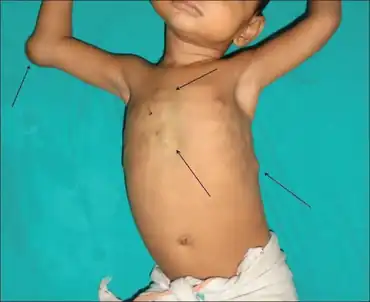Vitamin K deficiency
| Vitamin K deficiency | |
|---|---|
| Symptoms | bruising, petechiae, hematomas, oozing of blood at surgical or puncture sites, stomach pains, cartilage calcification, and severe malformation of developing bone or deposition of insoluble calcium salts in the walls of arteries. |
| Causes | insufficient dietary vitamin K1 or vitamin K2 or both |
| Medication | phytonadione |
Vitamin K deficiency results from insufficient dietary vitamin K1 or vitamin K2 or both.[1]
Signs and symptoms

Symptoms include bruising,[2] petechiae,[2][3] hematomas,[2] oozing of blood at surgical or puncture sites, stomach pains; risk of massive uncontrolled bleeding; cartilage calcification; and severe malformation of developing bone or deposition of insoluble calcium salts in the walls of arteries. In infants, it can cause some birth defects such as underdeveloped face, nose, bones, and fingers.[2]
Vitamin K is changed to its active form in the liver by the enzyme Vitamin K epoxide reductase. Activated vitamin K is then used to gamma carboxylate (and thus activate) certain enzymes involved in coagulation: Factors II, VII, IX, X, and protein C and protein S. Inability to activate the clotting cascade via these factors leads to the bleeding symptoms mentioned above.
Notably, when one examines the lab values in Vitamin K deficiency [see below] the prothrombin time is elevated, but the partial thromboplastin time is normal or only mildly prolonged. This may seem counterintuitive given that the deficiency leads to decreased activity in factors of both the intrinsic pathway (F-IX) which is monitored by PTT, as well as the extrinsic pathway (F-VII) which is monitored by PT. However, factor VII has the shortest half-life of all the factors carboxylated by vitamin K; therefore, when deficient, it is the PT that rises first, since the activated Factor VII is the first to "disappear." In later stages of deficiency, the other factors (which have longer half lives) are able to "catch up," and the PTT becomes elevated as well.
Cause
Vitamin K1-deficiency may occur by disturbed intestinal uptake (such as would occur in a bile duct obstruction), by therapeutic or accidental intake of a vitamin K1-antagonist such as warfarin, or, very rarely, by nutritional vitamin K1 deficiency. As a result, Gla-residues are inadequately formed and the Gla-proteins are insufficiently active.
Diagnosis
In terms of the diagnosis of Vitamin K deficiency the following is done :[4]
- Prothrombin time
- Increased levels of PIVKA-II
- Normal vitamin K levels (after IV-30 minutes)
Treatment
Management for this deficiency is age dependent as follows:[4]
- Newborns-Oral dosage of 2 mg Vitamin K1 when born and then a weekly dose of 1 mg (3 months)
- Adults-Oral dosage of 120 ug/day for males
- and 90 ug/day for females
- Vitamin K malabsorption-Will require oral vitamin K1 0.3 to 15 mg/day
Epidemiology
The prevalence of vitamin K deficiency varies by geographic region. For infants in the United States, vitamin K1 deficiency without bleeding may occur in as many as 50% of infants younger than 5 days old, with the classic hemorrhagic disease occurring in 0.25-1.7% of infants.[2] Therefore, the Committee on Nutrition of the American Academy of Pediatrics recommends that 0.5 to 1.0 mg Vitamin K1 be administered to all newborns shortly after birth.[5]
Postmenopausal and elderly women in Thailand have high risk of Vitamin K2 deficiency, compared with the normal value of young, reproductive females.[6] Current dosage recommendations for Vitamin K may be too low.[7] The deposition of calcium in soft tissues, including arterial walls, is quite common, especially in those suffering from atherosclerosis, suggesting that Vitamin K deficiency is more common than previously thought.[8]
Because colonic bacteria synthesize a significant portion of the Vitamin K required for human needs, individuals with disruptions to or insufficient amounts of these bacteria can be at risk for Vitamin K deficiency. Newborns, as mentioned above, fit into this category, as their colons are frequently not adequately colonized in the first five to seven days of life. Another at-risk population comprises those individuals on any sort of long-term antibiotic therapy, as this can diminish the population of normal gut flora.
See also
References
- ↑ "Vitamin K Deficiency: Background, Physiology, Complications and Prognosis". Archived from the original on 2020-11-29. Retrieved 2021-01-01.
{{cite journal}}: Cite journal requires|journal=(help) - 1 2 3 4 5 Vitamin K Deficiency Archived 2020-11-29 at the Wayback Machine eMedicine. Author: Pankaj Patel, MD. Coauthor(s): Mageda Mikhail, MD, Assistant Professor. Updated: Feb 13, 2014
- ↑ "Causes". Archived from the original on 2015-04-22. Retrieved 2021-01-01.
- 1 2 Eden, Rina E.; Coviello, Jean M. (2021). "Vitamin K Deficiency". StatPearls. StatPearls Publishing. Archived from the original on 11 November 2020. Retrieved 2 November 2021.
- ↑ American Academy of Pediatrics – Committee on Fetus and Newborn (July 2003). "Controversies concerning vitamin K and the newborn". Pediatrics. 112 (1): 191–2. doi:10.1542/peds.112.1.191. PMID 12837888. Archived from the original on 2020-11-03. Retrieved 2021-01-01.
- ↑ Bunyaratavej N (2007). "[Experience of vitamin K2 in Thailand]". Clin Calcium (in Japanese). 17 (11): 1752–60. PMID 17982197. Archived from the original on 2018-01-02. Retrieved 2021-01-01.
{{cite journal}}: CS1 maint: unrecognized language (link) - ↑ Adams J, Pepping J (2005). "Vitamin K in the treatment and prevention of osteoporosis and arterial calcification". Am J Health Syst Pharm. 62 (15): 1574–81. doi:10.2146/ajhp040357. PMID 16030366.
- ↑ Berkner KL, Runge KW (2004). "The physiology of vitamin K nutriture and vitamin K-dependent protein function in atherosclerosis". J. Thromb. Haemost. 2 (12): 2118–32. doi:10.1111/j.1538-7836.2004.00968.x. PMID 15613016.
External links
| Classification | |
|---|---|
| External resources |